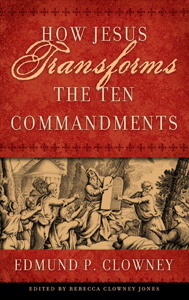
Edmund P. Clowney
Reviewed by: Matthew W. Kingsbury
How Jesus Transforms the Ten Commandments, by Edmund P. Clowney. Edited by Rebecca Clowney Jones. Published by P&R Publishing, 2007. Reviewed by OP pastor Matthew W. Kingsbury.
Studying the Sermon on the Mount is like cleaning off smudged glasses: Jesus removes the fog of interpretations that have diminished the power and authority of God’s law, allowing it to shine with illuminating clarity. Similarly, Edmund Clowney sets aside moralistic readings of the Ten Commandments to show how they reveal our Savior and his work.
Clowney was one of the greatest preachers of his generation and a popularizer of biblical theology. He taught pastors to preach Christ from all of Scripture, and church members to find Christ on its every page. Published posthumously, How Jesus Transforms the Ten Commandments continues that latter aspect of his ministry. In the introduction, he explains the redemptive-historical method (which reads the Bible as the story of how the Son of God came into the world to save his people from sin and death) and models it by carefully considering the Ten Commandments. In the conclusion, he summarizes each chapter and points the reader to Christ our Redeemer.
As Reformed Christians, we under stand how the law necessitated Christ: because we are condemned as sinners, we need Christ to keep the law for us and to suffer for our sins. Clowney moves beyond this to show how the law prophesied Christ. Jesus was the only one who was able to keep the law perfectly because it was patterned on him. For example, Jesus not only avoided adultery but through his work on the cross won himself a bride (the church), whom he is now making more beautiful and holy by his Spirit. That is, Christ’s whole work of redemption fulfills the law’s intent.
One should not think that “transform” in the title means “abrogate.” Clowney expects us to keep the letter of the law; still, we should do so to imitate Christ’s work as much as possible. For example, we can keep the eighth commandment by “meet[ing] the physical and spiritual needs of others” (p. 87).
The reader should be aware that some of the conclusions he draws on the first three commandments are at odds with our confessional standards. For instance, he suggests that cartoonlike, nonrepresentational pictures of Jesus may be permissible (pp. 29–32). Clowney may be right, but the Larger Catechism (Q. 109) states that no image whatsoever may be made of any person of the Trinity.
This is not an argument against reading this book; indeed, I highly recommend it for teen or adult Sunday school classes. However, these should be led by someone who is familiar with our standards and who can help members examine what the Scriptures say regarding the Ten Commandments. A thoughtful interaction with Clowney’s work and the Bible would honor his legacy as a pastor and preacher of Jesus Christ.
November 16, 2025
November 09, 2025
November 02, 2025
October 26, 2025
October 19, 2025
October 05, 2025
Raising Sexually Faithful Kids and
Parenting Boys and Girls in a Gender-Confused World
September 28, 2025
© 2025 The Orthodox Presbyterian Church